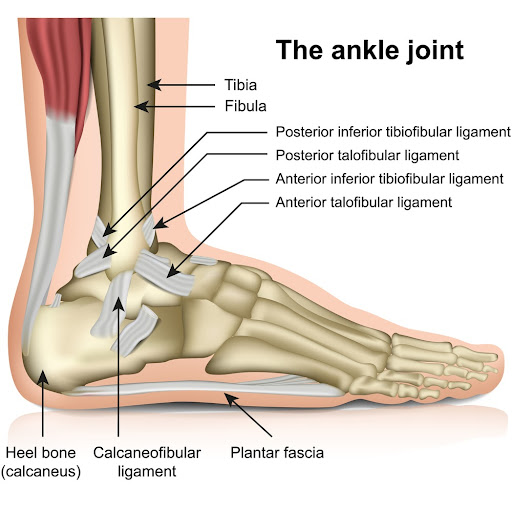
Dr. Gowreeson Thevendran
Internationally recognised Orthopaedic Surgeon with over 15 years of experience
MBChB (Bristol), MRCS.Ed, Dip. Sports Med.Ed, FRCS.Ed (Trauma & Ortho.), FAMS (Singapore)
Dr Gowreeson Thevendran is an orthopaedic surgeon with specialised expertise in foot and ankle surgery, including ankle ligament reconstruction. He also has a deep understanding of the complexities of ankle instability and offers comprehensive care for patients with ligament injuries. He received his medical education from the University of Bristol and completed his surgical training in the UK and Canada. Before establishing his private practice, he served as Chief of Foot & Ankle Surgery, Department of Orthopaedics at Tan Tock Seng Hospital, Singapore.
What is Minimally Invasive Ankle Ligament Reconstruction Surgery
Ankle ligament surgery, formally known as ligament reconstruction, is a surgical procedure aimed at repairing or strengthening damaged ligaments within the ankle to restore stability and function. This operation is typically performed by an orthopaedic surgeon, a specialist in diagnosing and addressing injuries and disorders involving the musculoskeletal system.
Minimally invasive ankle ligament reconstruction also offers several advantages over traditional open surgery. For instance, instead of large incisions, surgeons use specialised instruments and small incisions, or even just “keyhole” incisions, to access and repair the damaged ligaments. Additionally, this surgical approach results in less pain, faster recovery, reduced scarring, and lower risk of complications.
There are two main methods for minimally invasive ankle ligament reconstruction:
- Arthroscopic Surgery: This involves inserting a tiny camera and instruments through small incisions to visualise and repair the ligaments.
- Percutaneous Technique: This uses a small, stab incision to access and repair the ligaments, often with the assistance of specialised instruments.

Who Needs This Type of Surgery?
Ankle ligament surgery is typically considered when individuals experience persistent ankle instability, even after receiving proper sprained ankle treatments, such as physical therapy, bracing, and rest. This situation often arises in cases where the ligaments have been severely stretched or torn, leading to frequent sprains and a feeling of the ankle “giving way” during everyday activities or sports.
Some groups of people who might benefit from this surgery include:
- Athletes: Athletes, especially those involved in high-impact sports that involve jumping, pivoting, or cutting movements, are prone to ankle ligament injuries. Surgery can also help them regain stability and return to their sport safely.
- Patients with Chronic Ankle Instability: If you have a history of recurrent ankle sprains and persistent instability, surgery can help stabilise the joint and prevent further injuries.
- Patients with Significant Ligament Damage: In cases where the ligament is severely torn or unable to heal properly on its own, surgical reconstruction may be necessary to restore ankle function.
- Patients with Associated Conditions: If your ankle instability is accompanied by other conditions like arthritis or cartilage damage, surgery can address these issues comprehensively.
- Patients with Hyperlaxity: Individuals with naturally loose ligaments or connective tissue disorders may experience frequent ankle sprains and benefit from surgery to improve stability.
Additionally, surgery may be necessary if there is significant damage to the ligament that cannot heal properly on its own. In this case, your doctor may suggest an ankle ligament reconstruction surgery to prevent further damage.
What Happens During Ankle Ligament Surgery
Ankle ligament reconstruction surgery involves a series of steps to repair and stabilise the damaged ligaments in your ankle:
Pre-Operative Assessment:
Before surgery, your orthopaedic surgeon will conduct a thorough assessment to evaluate the extent of your ankle instability and plan the most appropriate surgical approach. This assessment typically includes:
- Physical Examination: Your surgeon will examine your ankle, checking for instability, tenderness, and range of motion.
- Imaging Tests: X-rays or MRI scans may be necessary to visualise the ligaments and any associated injuries, such as cartilage damage.
Surgical Procedure:
As mentioned, ankle ligament reconstruction surgery can be performed using minimally invasive techniques like arthroscopic surgery and percutaneous surgery. At the same time, the surgeon may use specialised instruments and sutures to tighten or reconstruct the ligaments, often with the assistance of a small camera. In some cases, the surgeon may need to use a tissue graft from another part of your body or a donor to reinforce the repair. Note that this is more common in cases of severe ligament damage or revision surgeries.
Anaesthesia:
Ankle ligament reconstruction surgery is typically performed under general anaesthesia, meaning you’ll be asleep during the procedure. In some cases, a regional anaesthetic (spinal or epidural) may be used to numb the lower half of your body.
Post-Operative Care:
After surgery, you’ll be monitored in a recovery area. Also, you’ll likely have a bandage or splint on your ankle and may need to use crutches initially. Additionally, your surgeon will provide detailed instructions on post-operative care, including pain management, wound care, and activity restrictions. You’ll also be scheduled for follow-up appointments to monitor your healing and progress.
Can the Ankle Ligament Heal Without Reconstruction Surgery?
Aside from ligament issues within the ankle joint, it is important to note that pain in the area may also stem from damaged cartilage. If you are experiencing ankle pain and instability, it is crucial to first determine whether it is due to a ligament or cartilage injury, as this will influence the type of management strategies needed.
Ultimately, only a qualified healthcare professional, such as an orthopaedic specialist, can determine if ankle ligament surgery is required.
Pros and Cons of Ankle Ligament Surgery
Ankle ligament surgery, especially when performed with minimally invasive techniques, offers numerous benefits. However, like other procedures like metatarsalgia surgery and flat foot reconstruction surgery, there are potential risks that you need to consider.
Pros
- Improved Stability: The primary benefit of ankle ligament surgery is restoring stability to the ankle joint, reducing the likelihood of recurrent sprains and instability.
- Reduced Pain: Surgery can alleviate chronic pain caused by ankle instability and ligament damage.
- Improved Function: By stabilising the ankle, surgery can improve your ability to participate in activities and sports.
- Minimally Invasive Options: Minimally invasive techniques result in smaller incisions, less pain, faster recovery, and reduced scarring compared to traditional open surgery.
- Lower Risk of Complications: Minimally invasive surgery is associated with a lower risk of infection, wound complications, and nerve injury.
Cons
- Potential Complications: While generally safe, ankle ligament surgery carries potential risks, such as infection, stiffness, swelling, and nerve injury. However, as mentioned, these risks are minimised with minimally invasive techniques.
- Recovery Time: Even with minimally invasive surgery, recovery takes time, and you’ll need to follow post-operative instructions, participate in physical therapy, and gradually return to activities.
- Anaesthesia Risks: As with any surgery requiring anaesthesia, there are inherent risks associated with the anaesthesia itself.
Recovery Time
After an ankle ligament surgery, some individuals may require the support of crutches for several weeks, depending on their recovery time and rehabilitation progress.
The recovery period following the ligament reconstruction involves several stages, starting with rest and protection of the ankle, followed by gradually increasing mobility with the aid of physical therapy. During the initial period after the surgery, swelling and discomfort are typically managed with medication, elevation, and ice.
Once the incisions have healed, special strength and flexibility exercises are gradually introduced as part of the rehabilitation programme. These exercises are designed to help with the ankle’s range of motion, strengthen the muscles around the joint, and facilitate the return to pre-injury levels of function and stability.
It is important to note that the time taken for full recovery varies depending on the individual’s condition and the surgery’s extent. However, most patients should observe some improvements over time and with the help of diligent rest, post-surgery rehabilitation exercises and good foot and ankle care.
Ankle Ligament Reconstruction Success Rate
Ankle ligament reconstruction surgery, when performed by a skilled and experienced surgeon generally has a high success rate in restoring ankle stability and function.
Dr. Gowreeson’s commitment to personalised care, combined with his expertise in ankle and foot surgery, contributes to the success rates for ankle ligament reconstruction. He will thoroughly assess your condition, discuss your expectations, and provide a realistic outlook on the potential outcomes of surgery.
It’s important to note that successful outcomes also depend on patient commitment to post-operative rehabilitation and following medical advice. But by working together, you and Dr. Gowreeson can achieve the appropriate results for your ankle health.
Alternative Treatments to Ankle Ligament Surgery
While minimally invasive ankle ligament surgery is often the preferred approach for addressing chronic ankle instability, there are alternative treatments to consider. These may be suitable for individuals with less severe instability or those who prefer to avoid surgery initially.
Non-Surgical Options:
- Bracing: Wearing a supportive brace can help stabilise the ankle and prevent excessive movement, reducing the risk of further sprains.
- Physical Therapy: A physical therapist can guide you through exercises to strengthen the muscles around your ankle, improve balance, and enhance proprioception (your body’s awareness of its position in space).
- Medications: Over-the-counter pain relievers can help manage pain and inflammation.
- Activity Modification: Avoiding activities that aggravate your ankle instability can help reduce symptoms and allow the ligaments to heal.
- Injections: In some cases, your doctor may recommend corticosteroid injections to reduce inflammation and pain.
Traditional Open Surgery:
Another alternative is traditional open surgery. This involves a larger incision and more extensive tissue disruption, leading to increased pain, longer recovery time, and a higher risk of complications compared to minimally invasive techniques.
Am I a Candidate?
If you’re struggling with persistent ankle pain, instability, or recurrent sprains, ankle ligament reconstruction surgery might be an option to provide long-term relief and restore function, allowing you to return to the activities you enjoy. However, it’s always best to seek an evaluation from an experienced orthopaedic specialist like Dr. Gowreeson Thevendran if you’re experiencing any of these symptoms. He will conduct a thorough assessment to determine the extent of your ankle instability and discuss whether surgery is the right option for you.
Don’t let ankle instability hold you back any longer. Schedule a consultation at OrthofootMD today to discuss your treatment options and explore the possibility of ankle ligament reconstruction surgery.
Dr. Gowreeson Thevendran’s Qualifications and Awards
- Bachelor of Medicine and Surgery, University of Bristol, England
- Fellow of the Royal College of Surgeons, Edinburgh
- Diplomate Faculty of Sports and Exercise Medicine, Royal College of Surgeons Edinburgh
- Fellow of the Academy of Medicine, Singapore
- SICOT PIONEER Founders Award 2020
- 2015 European Foot & Ankle Society ‘Best Podium Presentation’ Award
- 2013 Singapore Orthopaedic Association Junior Travelling Fellowship
- 2012 NHG Critical Talent Special Recognition Award
- 1998 Enid Lindt Prize in Clinical Surgery
- 1995 Public Services Department Full Medical Scholarship
COMMON ORTHOPAEDIC CONDITIONS WE TREAT
GENERAL
Frequently Asked Questions about Ankle Ligament Surgery
Symptoms of a torn ankle ligament will usually include:
- Hearing or feeling a pop at the time of injury
- Bruising and swelling around your heel and/or toe area
- Pain and/or difficulty putting weight on your ankle
Depending on the severity of your torn ligament, you might need ankle ligament reconstruction surgery to restore the stability of your ankle.
You may still be able to walk, but not without experiencing pain. That being said, this is not advisable as it will prolong recovery.
Without timely treatment, you are more likely to experience chronic pain and instability in your ankle. This could lead to further tearing of the ligaments, which would require surgery before you can fully recover from this injury. An untreated ankle ligament tear may also leave you susceptible to more injuries in the long run.
The risks or complications associated with ankle ligament surgery can include excessive blood loss, infection, nerve damage, blood clots, and anaesthesia-induced complications. Additionally, there’s a possibility of stiffness and reduced range of motion in the ankle. These outcomes underscore the importance of discussing potential risks with a healthcare provider before proceeding with surgery.
Yes, insurance and MediSave can cover ankle ligament surgery. However, the coverage will depend on the extent of your injury and your insurance plan. Hence, patients are recommended to visit the clinic and confirm the eligibility of their treatment for MediSave claims and the level of coverage offered by their insurance plan.
Yes, many individuals are able to return to sports after ligament reconstruction. However, the timeline and safety of doing so depend on the extent of the ankle surgery and your recovery progress, as every individual will heal differently. To determine when you can resume sporting activities, you should consult your attending healthcare provider.
Dr Gowreeson Thevendran is currently an orthopaedic surgeon with Island Orthopaedic, a one-stop care centre for orthopaedic health under Healthway Medical Group. He specialises in treating lower limb orthopaedic conditions, as well as trauma and fracture surgery of both the upper and lower limbs. Prior to establishing his private practice, Dr Gowreeson was Chief of Foot & Ankle Surgery at the Department of Orthopaedics at Tan Tock Seng Hospital (TTSH). Today, he continues to serve the Orthopaedic Department at TTSH as a visiting consultant.
About Dr. Gowreeson Thevendran


